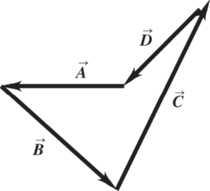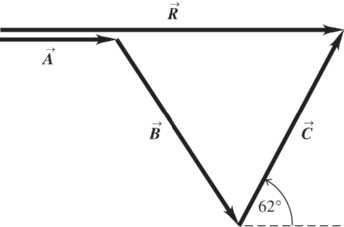MODELS, MEASUREMENTS, AND VECTORS
Answers to Multiple-Choice Problems
Solutions to Problems
*1.1. Set Up: We know the following equalities: 3 1 mg10 g; = 6 1g10 g; μ = 1 kilohms1000 ohms; = and 3 1 milliamp10 amp =.
Solve: In each case multiply the quantity to be converted by unity, expressed in different units. Construct an expression for unity so that the units to be changed cancel and we are left with the new desired units.
(a) 3 2 10 g (2400 mg/day)240 g/day4 1 mg
(b) 6 4 10 g (120 g/day)12010 g/day 1 g μ μ
(c) 3 10 g (500 mg/day)0500 g/day 1 mg
(d) 3 1 kilohm (1500 ohms)150 kilohms 10 ohms
=.
(e) 3 1 milliamp (0020 amp)20 milliamps 10 amp
.== ⎜⎟
Reflect: In each case, the number representing the quantity is larger when expressed in the smaller unit. For example, it takes more milligrams to express a mass than to express the mass in grams.
1.2. Set Up: From the meaning of the metric prefixes we know: 6 1 megaohm1 M10 ohms; =Ω= 1 picofarad = 1 pf = 12 10 farad; 9 1 gigameter1 Gm10 m; == 9 1 nanometer1 nm10 m; == and 15 1 femtometer1 fm10 m ==.
Solve: (a) 6 6 10 ohms (785 megohms)78510 ohms 1 megaohm
(b) 12 12 10 farad (5 picofarads)510 picofarad 1 picofarad
=×
(c) 8 9 1 gigameter (30010 m/s)0300 gigameter/s 10 m
(d) 9 7 10 meter (400 nm)40010 meter;
(e) 15 15 10 meter (2 femtometer)210 meter 1 femtometer
1.3. Set Up: We know the equalities: 3 1 mg10 g, = 6 1 g10 g, μ = and 3 1 kg10 g =.
Solve: (a) 3 5 6 10 g1 g (410 mg/day)41010g/day 1 mg 10 g μ μ
(b) 3 10 g (12 mg/kg)(75 kg)(900 mg)0900 g 1 mg
(c) The mass of each tablet is 3 3 10 g (20 mg)2010 g 1 mg
The number of tablets required each day is the number of grams recommended per day divided by the number of grams per tablet:
3 00030 g/day 15 tablet/day 2010 g/tablet . =.. .× Take 2 tablets each day.
(d) 3 1 mg (0000070 g/day)0070 mg/day 10 g
1.4. Set Up: In part (a), we need to solve an equation of the form 254 cm (10 mi) 100 in x y,
where x is a series of conversion equalities and y is the unknown number of kilometers. For part (b), we must prove 3 (100 mL)100 cm x .=. using the equalities 3 1 L1000 cm = and 103 mL1 L =. Part (c) requires the application of the equality 3 1 mL1 cm =.
Solve: (a) 3 254 cm120 in5280 ft100 m100 km (100 mi); 100 in100 ft100 mi100 cm 10 m y
(b) 3 3 3 100 L1000 cm (100 mL)100 cm 100 L 10 mL
(c) 33 3 10 mL100 cm (100 L)1000 cm 100 L100 mL
161 km y =.
*1.5. Set Up: We need to apply the following conversion equalities: 1000 g100 kg, =. 100 cm100 m, =. and 3 100L1000 cm . =.
Solve: (a) 3 33 100 kg100 cm (100 g/cm)1000 kg/m 1000 g100 m
© Copyright 2012 Pearson Education, Inc. All rights reserved. This material is protected under all copyright laws as they currently exist. No portion of this material may be reproduced, in any form or by any means, without permission in writing from the publisher.
(b) 3 33 1000 g100 m (1050 kg/m)105 g/cm 100 kg1000 cm
(c) 3 3 1000 cm100 g100 kg (100 L)100 kg; 100 L1000 g 100 cm
2205 lb (100 kg)220 lb 100 kg
Reflect: We could express the density of water as 100 kg/L
1.6. Set Up: From the appendices we find the conversion from kilometers into miles, and the radius and period of the earth’s orbit: 11 1 km06214 mi; 15010 m; 3653 days rT =.=.×=.. Since the earth’s orbit is nearly circular, its circumference is 2 Cr π =.
4 0.6214 mi km/h)6.6810 mi/h
=×
Reflect: To minimize rounding errors, we should avoid rounding in intermediate calculations: this is why we used 1075105 km/h .× rather than 108105 km/h .× to calculate our final answer. The significant digits are underlined.
1.7. Set Up: The speed of light is 300108 m/s; v =.× 1 ft03048 m; =. 9 1 s10 ns; = /.tdv =
Solve: 9 8 03048 m 10210 s102 ns
30010 m/s t . ==.×=.
Reflect: In 1.00 s light travels 30010855 m30010 km18610 mi. .×=.×=.×
1.8. Set Up: We know: 1 in254 cm; =. 2 1 cm10 m; = and 3 1 mm10 m =.
Solve: (a) () 2 3 83 254 cm10 m1 mm in95 mm 1 in1 cm 10 m
(b) 3 2 10 m1 cm1 in (12 mm)047 in 1 mm254 cm 10 m
(c) Express and compare the English wrench sizes as decimal values: 3 8 0375 in,
The 1 2 -inch wrench is closest to 12 mm.
*1.9. Set Up: We apply the equalities of 1 km06214 mi =. and 1 gal3788 L =..
Solve: 1 km1 gal (375 mi/gal)159 km/L 06214 mi3788 L
in.
Reflect: Note how the unit conversion strategy, of cancellation of units, automatically tells us whether to multiply or divide by the conversion factor.
1.10. Set Up: Apply the given conversion factors, 1 furlong01250 mi =. and 1 fortnight14 days, = along with 1 day24 h =.
© Copyright 2012 Pearson Education, Inc. All rights reserved. This material is protected under all copyright laws as they currently exist. No portion of this material may be reproduced, in any form or by any means, without permission in writing from the publisher.
Solve: 0125 mi1 fortnight1 day (180,000 furlongs/fortnight)67 mi/h
1 furlong14 days24 h
1.11. Set Up: We know: 1 euro$125; =. and 1 gal3788 L =..
Solve: $1253788 L (135 euros/L)$639 per gallon
1 euro1 gal
Currently, in 2005, gasoline in the U.S. costs about $2 per gallon so the price in Europe is about three times higher.
1.12. Set Up: From Appendix A, the volume V of a sphere is given in terms of its radius as 3 4 3 Vr π = while its surface area A is given as 2 4 Ar π =. Also, by definition, the radius is one-half the diameter or /210m rd μ ==. . Finally, the necessary equalities for this problem are: 6 1m10 m; μ = 2 1 cm10 m; = and 3 1 mm10 m =.
Solve:
*1.13. Set Up: We apply the basic time relations of 1 h60 min = and 1 min60 s = in part (a) and use the result of (a) in part (b). Similarly, apply the result of part (b) in solving part (c).
Solve: (a) 60 min60 s (1 h)3600 s 1 h1 min
=
(b) [ ] 3 (24 h/day)(3600 s)/(1 h)86410 s/day =.×
(c) 37 (365 day/yr)[(86410 s)/(1 day)]31,536,000 s/yr31510 s/yr .×==.×
1.14. Set Up: (a) The appropriate equalities required are: 1 mi1609 m; = 1 h3600 s; = 1 mph04470 m/s; =. 1 ft03048 m; =. and 1 mi5280 ft =.
Solve: (a) 85 1 mi (30010 m/s)18610 mi/s; 1609 m
88 1 mi3600 s (30010 m/s)67110 mph 1609 m1 h
(b) 03048 m (1100 ft/s)335 m/s; 1 ft ⎛⎞ =
1 mi3600 s (1100 ft/s)750 mph 5280 ft1 h
(c) 5280 ft1 h (60 mi/h)88 ft/s 1 mi3600s
=
(d) 22 1 ft (98 m/s)32 ft/s 03048 m
1.15. Set Up: In each case, round the last significant figure.
Solve: (a) 3.14, 3.1416, 3.1415927 (b) 2.72, 2.7183, 2.7182818 (c) 3.61, 3.6056, 3.6055513 Reflect: All of these representations of the quantities are imprecise, but become more precise as additional significant figures are retained.
1.16. Set Up: Use a calculator to calculate the decimal equivalent of each fraction and then round the numeral to the specified number of significant figures. Compare to π rounded to the same number of significant figures.
© Copyright 2012 Pearson Education, Inc. All rights reserved. This material is protected under all copyright laws as they currently exist. No portion of this material may be reproduced, in any form or by any means, without permission in writing from the publisher.
Models, Measurements, and Vectors
Solve: (a) 3.14286 (b) 3.14159 (c) The exact value of π rounded to six significant figures is 3.14159. Since the fraction 22/7 differs in the fourth significant figure, it is accurate to only three significant figures. The fraction 355/113 and π agree when expressed to six figures and thus agree to this precision.
*1.17. Set Up: Calculate the trig function with the maximum and minimum possible values of the angle.
Solve: (a) cos 3509981 .=. and cos 4509969, .=. so the range is 0.9969 to 0.9981.
(b) sin 350061 .=. and sin 450078, .=. so the range is 0.061 to 0.078.
(c) tan 350061 .=. and tan 450079, .=. so the range is 0.061 to 0.079.
1.18. Set Up: We know the relations: massdensityvolume; g =× and 33 100 L10010cm .=.×.
Solve: Water 3333 (100 g/cm)(10010 cm)10010 g; m =..×=.×
Blood: 3333 (105 g/cm)(10010 cm)10510 g; m =..×=.×
Seawater: 3333 (103 g/cm)(10010 cm)10310 g m =..×=.×.
*1.19. Set Up: We are given the relation density = mass/volume = m/V where 3 4 3 Vr π = for a sphere. From Appendix F, the earth has mass of 5971024 kg m =.× and a radius of 6 63810m r =.× whereas for the sun at the end of its lifetime, 30 19910kg m =.× and r = 7500 6 km7510m =.×. The star possesses a radius of r = 10 km = 4
Reflect: For a fixed mass, the density scales as 3 1/r Thus, the answer to (c) can also be obtained from (b) as 3 6 63143 4 75010m (1110g/cm)4710g/cm
1.20. Set Up: To calculate the densities, we need to find the spherical volume, 3 4 3 , Vr π = and the mass of the atom or nucleus as the sum of the masses of its constituent particles. For the atom, p ne 2()mmmm =++ while for the nucleus p n 2()mmm=+. We thus need mass data from Appendix F: 27 p 167310kg; m =.× nm = 27 167510kg; .× and 31 e 910910 kg m =.×. The unit conversion factor 33 1 g/cm1000 kg/m = is also needed.
Solve:
© Copyright 2012 Pearson Education, Inc. All rights reserved. This material is protected under all copyright laws as they currently exist. No portion of this material may be reproduced, in any form or by any means, without permission in writing from the publisher.
The density of the helium atom is 13 times larger than the density of pure water.
(b) Given 15 10 fm1010m, r =.=.× 443153453 33 (1010m)41910m Vrππ ==.×=.×. 27 pn 2()67010kgmmm=+=.× 27 183153 453 67010kg density1610kg/m1610g/cm 41910m m V .× ===.×=.× .×
In Problem 1.19 we found the density of a neutron star to be 4710g/cm143 .×. By comparison, the density of the helium nucleus is 3 times larger than the density of a neutron star.
1.21. Set Up: We know the density and mass; thus we can find the volume using the relation density = mass/volume = m/V and the given data, 3 density195 g/cm =. and critical 600 kg m =.. The radius is then found from the volume equation for a sphere, 3 4 3 , Vr π = and the result for volume.
Solve: 3 critical 3 600 kg1000 g /density3080 cm 10 kg 195 g/cm
1.22. Set Up: From Appendix A, a thin spherical shell has volume , VAt = where 2 4 Ar π = is the surface area of the shell and t is its thickness. We are given 6 10m1010m r μ =. =.× and 9 500 nm50010m, t =.=.× and we know the unit conversions 363 1 m10cm = and 3 1 mg10g =.
Solve: 2629193133 44(1010m)(50010m)62810m62810cmVrtππ ==.×.×=.×=.×
31331310 mass(density)(volume)(10 g/cm)(62810cm)62810g62810mg==..×=.×=.×
*1.23. Set Up: The mass can be calculated as the product of the density and volume. The volume of the washer is the volume dV of a solid disk of radius dr minus the volume hV of the disk-shaped hole of radius hr . In general, the volume of a disk of radius r and thickness t is 2 rtπ We also need to apply the unit conversions 363 1 m10 cm = and 333 1 g/cm10 kg/m =.
Solve: The volume of the washer is:
22223dhdh()[(225 cm)(0625 cm)](0150 cm)220 cm VVVrrtππ =−=−=.−..=.
The density of the washer material is 33333 8600 kg/m[(1 g/cm)/(10 kg/m)]860 g/cm =.. Finally, the mass of the washer is: 33 mass(density)(volume)(860 g/cm)(220 cm)189 g ==..=..
Reflect: This mass corresponds to a weight of about 0.7 oz, a reasonable value for a washer.
1.24. Set Up: The world population when this solution is being written is about 9 6410people .×. Estimate an average mass of a person to be about 50 kg, which corresponds to a weight of about 110 lbs.
Solve: The total mass of all the people is about 911 (50 kg/person)(6410persons)310kg .×=×
1.25. Set Up: Estimate the number of pages and the number of words per page: There are approximately a thousand pages, and each page has between 500 and 1000 words (counting captions and the smaller print, such as the end-of-chapter exercises and problems).
Solve: An estimate for the number of words is about 6 10.
Reflect: We can expect that this estimate is accurate to within a factor of 10.
© Copyright 2012 Pearson Education, Inc. All rights reserved. This material is protected under all copyright laws as they currently exist. No portion of this material may be reproduced, in any form or by any means, without permission in writing from the publisher.
1.26. Set Up: Assume that the density of a cell is 3 1000 kg/m, the same as for water. Also assume a mass of 70 kg (a weight of about 150 lbs) for a typical person. The volume of a sphere is 3 4 3 Vr π =.
Solve: The volume is: 44363183 33 (1010m)4210m Vrππ ==.×=.×. The mass of a cell is:
318315 mass(density)(volume)(1000 kg/m)(4210m)410kg==.×=×
The number of cells in the typical person is then 1516 (70 kg)/(410kg/cell)210cells ×=×.
*1.27. Set Up: Estimate that we blink 10 times per minute and a typical lifetime is 80 years. Convert this into blinks per lifetime using 1 y365 days, = 1 day24 h, = 1 h60 min. =
Solve: The number of blinks is 8 60 min24 h365 days (10 per min)(80 y/lifetime)410 1 h1 day1 y
Reflect: Our estimate of the number of blinks per minute can be off by a factor of two but our calculation is surely accurate to a power of 10.
1.28. Set Up: Estimate the diameter of a drop to be 2 mm. d = The volume of a spherical drop is 4133 36 Vrd =π=π and 1033cm1 L =
Solve: 333 1 6 (02 cm)410 cm. V π =.=× The number of drops in 1.0 L is
3
5 33 1000 cm 210 410 cm =× ×
Reflect: Since 3 , Vd ∝ if our estimate of the diameter of a drop is off by a factor of 2 then our estimate of the number of drops is off by a factor of 8.
1.29. Set Up: Estimate the thickness of a dollar bill by measuring a short stack, say ten, and dividing the measurement by the total number of bills. I obtain a thickness of roughly 1 mm. From Appendix F, the distance from the earth to the moon is 38108 m .×. The number of bills is simply this distance divided by the thickness of one bill.
Solve: 83 1212 bills 3810m10mm 3810bills410bills 01 mm/bill1 m
Reflect: This answer represents 4 trillion dollars! The cost of a single space shuttle mission in 2005 was significantly less—roughly 1 billion dollars.
1.30. Set Up: For part (a), estimate that a person takes 12 breaths per minute. In part (b), use the relation for the volume of a sphere, 3 4 3 , Vr π = to calculate the radius required as 13 [3/(4)] / rV π =.
Solve: (a) The estimated number of breaths in two weeks equals:
5 60 min24 h7 days (12 breaths/min)(2 weeks)2410breaths 1 h1 day1 week
The total amount of air breathed by one person in two weeks is:
33 523 1 2 10m L/breath(2410breaths)110m 1
(b) For a spherical vehicle, the radius required is: 1/3 1/3 23 33(110m) 3
The diameter of the space station needs to be about 6 m to contain the air for one person for two weeks.
*1.31. Set Up: An average middle-aged (40 year-old) adult at rest has a heart rate of roughly 75 beats per minute. To calculate the number of beats in a lifetime, use the current average lifespan of 80 years. The volume of blood pumped during this interval is then the volume per beat multiplied by the total beats.
© Copyright 2012 Pearson Education, Inc. All rights reserved. This material is protected under all copyright laws as they currently exist. No portion of this material may be reproduced, in any form or by any means, without permission in writing from the publisher.
Solve:
1.32. Set Up: Estimate that one step is 1 3 m Estimate that you walk 100 m in 1 minute. The distance to the Moon is 8 3810m .×.
Solve: The time it takes is
which is about 7 years. The number of steps would be:
*1.33. Set Up: The cost would equal the number of dollar bills required; the surface area of the U.S. divided by the surface area of a single dollar bill. By drawing a rectangle on a map of the U.S., the approximate area is 2600 mi by 1300 mi or 3,380,000 2 mi . This estimate is within 10 percent of the actual area, 3,794,083 2 mi . The population is roughly 30108 .× while the area of a dollar bill, as measured with a ruler, is approximately 1 8 6 in. by 5 8 2 in.
Solve: 222162 US. (3,380,000 mi)[(5280 ft)/(1 mi)][(12 in)/(1 ft)]1410in A =.=.×.
2 bill (6125 in)(2625 in)161 in A =....=..
1486 Cost per person(910dollars)/(3010persons)310dollars/person =×.×=×
Reflect: The actual cost would be somewhat larger, because the land isn’t flat.
1.34. Set Up: Convert the radian values to degrees as: rad60; 3 π = and rad30 6 π =.
Solve: The vectors are shown in the figure below.
*1.35. Set Up: The sum with the largest magnitude is when the two displacements are parallel and the sum with the smallest magnitude is when the two displacements are antiparallel.

Solve: The orientations of the displacements that give the desired sum are shown in the figure below.
© Copyright 2012 Pearson Education, Inc. All rights reserved. This material is protected under all copyright laws as they currently exist. No portion of this material
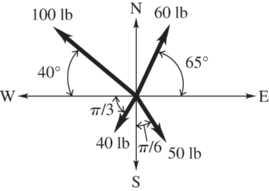
Reflect: The orientations of the two displacements can be chosen such that the sum has any value between 0.6 m and 4.2 m.
1.36. Set Up: The displacement vector is directed from the initial position of the object to the final position.
Solve: (a) The initial and final positions of the bug are shown in Figure (a) below. The curved path of the bug is shown in Figure (b) and the bug’s displacement vector is shown in Figure (c).

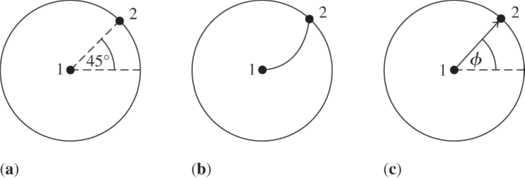
(b) The magnitude of the displacement vector is the length of the line that connects points 1 and 2 and is equal to the radius of the turntable, 6 inches. The direction of the displacement vector is shown in Figure (c) above, with 45 φ=.
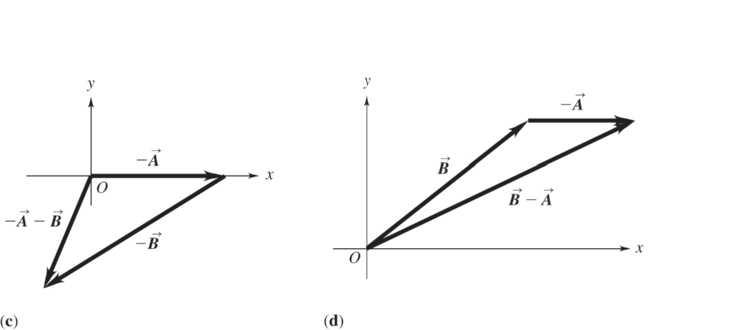
1.37. Set Up: Draw the vectors to scale on graph paper, using the tip to tail addition method. For part (a), simply draw B so that its tail lies at the tip of A Then draw the vector R from the tail of A to the tip of B For (b), add B to A by drawing B in the opposite direction to B For (c), add A to −. B For (d), add A to B Solve: The vector sums and differences are shown in the figures below.
© Copyright 2012 Pearson Education, Inc. All rights reserved. This material is protected under all copyright laws as they currently exist. No portion of this material may be reproduced, in any form or by any means, without permission in writing from the publisher.
Reflect: ()−−=−+ABAB so it has the same magnitude and opposite direction as +.AB Similarly, −= B A () AB and B A and AB have equal magnitudes and opposite directions.
1.38. Set Up: The two forces applied by the cables add to give a resultant force that is vertical and has magnitude 2.25 N. Draw the vector addition diagram with the two forces head to tail. Solve: (a) The vector addition diagram is drawn in the figure below.
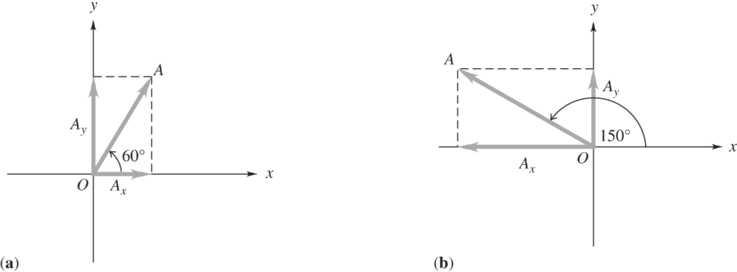
(b) Careful measurement of the length of 1F and 2F gives 12 124 N FF==..
*1.39. Set Up: Use components to add the two forces. Take the -direction x + to be forward and the -direction y + to be upward.
Solve: The second force has components 22 cos324433 N x FF=.°= and 22 sin324275 N y FF=.°=. The first force has components 1 725 N x F = and 1 0 y F =.
12 1158 N FFFxxx=+= and 12 275 N FFFyyy=+=
The resultant force is 1190 N in the direction 134.° above the forward direction. Reflect: Since the two forces are not in the same direction the magnitude of their vector sum is less than the sum of their magnitudes.
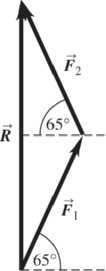
1.40. Set Up: In each case the direction of the vector is specified by the angle θ measured counterclockwise from the +x axis. The components are calculated as: cos ; x AA θ = sin y AA θ =.
Solve: (a) (500 N)(cos 60)250 N; Ax =.=+. (500 N)(sin 60)433 N Ay =.=+.. The sketch of the vector and its components in Figure (a) below shows that both components are positive and that Ayx A >. qqqq
© Copyright 2012 Pearson Education, Inc. All rights reserved. This material is protected under all copyright laws as they currently exist. No portion of this material may be reproduced, in any form or by any means, without permission in writing from the publisher.
(b) (5/6 rad)(180/ rad)150; θππ == (75 m/s)(cos 150)650 m/s; Ax ==−. (75 m/s)(sin 150)375 m/s Ay ==+..
Figure (b) above shows that Ax is negative, Ay is positive, and x AAy>. qqqq
(c) (254 lb)(cos 325)208 lb; Ax == (254 lb)(sin 325)146 lb Ay ==−. Figure (c) above shows that Ax is positive, Ay is negative, and x AAy>. qqqq
(d) (11 rad)(180/ rad)198; θππ =.= (69 km)(cos 198)66 km; Ax ==− (69 km)(sin 198)21 km Ay ==−. Figure
(d) above shows that both Ax and Ay are negative and x AAy>. qqqq
*1.41. Set Up: In each case, create a sketch (see the figure below) showing the components and the resultant to determine the quadrant in which the resultant vector A lies. The component vectors add to give the resultant.
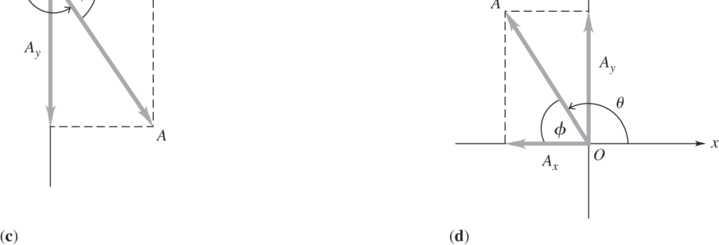
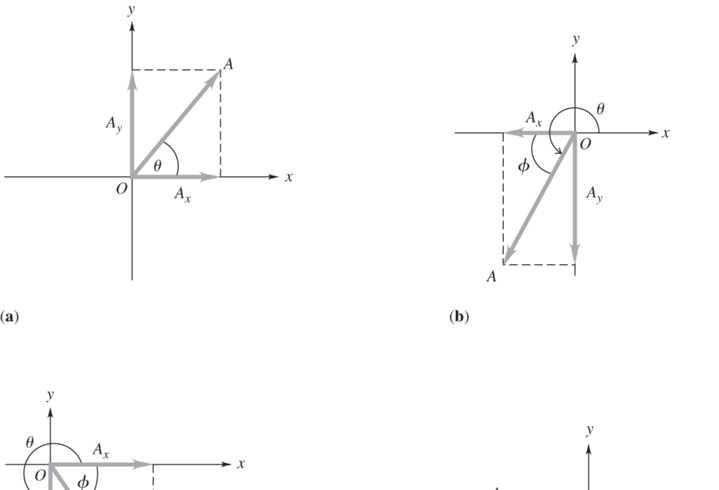
© Copyright 2012 Pearson Education, Inc. All rights reserved. This material is protected under all copyright laws as they currently exist. No portion of this material may be reproduced, in any form or by any means, without permission in writing from the publisher.

Solve: (a) 2222 (40 m)(50 m)64 m; AAAxy=+=.+.=. 50 m tan 40 m y x
A A θ . == and 51 θ=.
(b) 22 (30 km)(60 km)67 km; A =−.+−.=. 60 m tan 30 m θ −. = −. and 243. θ=
(My calculator gives 63 φ= and 180)θφ=+.
(c) 22 (90 m/s)(17 m/s)19 m/s; A =.+−= 17 m/s tan 9 m/s θ= and 298 θ=.
(My calculator gives 62φ=− and 360)θφ=+.
(d) 22 (80 N)(12 N)14 N A =−.+=. 12 N tan 80 N θ= −. and 124. θ=
(My calculator gives 56 φ= and 180)θφ=+.
Reflect: The signs of the components determine the quadrant in which the resultant lies.
1.42. Set Up: Use coordinates for which the +x axis is horizontal and the +y direction is upward. The force F and its x and y components are shown in the figure below.

Solve: (a) (cos 37)(200 N)(cos 37)160 N x FF==.=.
(b) sin 37(200 N)(sin 37)120 N y FF==.=.
*1.43. Set Up: In each case, use a sketch (see the figure below) showing the components and the resultant in order to determine the quadrant in which the resultant vector A lies. The component vectors add to give the resultant.
© Copyright 2012 Pearson Education, Inc. All rights reserved. This material is protected under all copyright laws as they currently exist. No portion of this material may be reproduced, in any form or by any means, without permission in writing from the publisher.
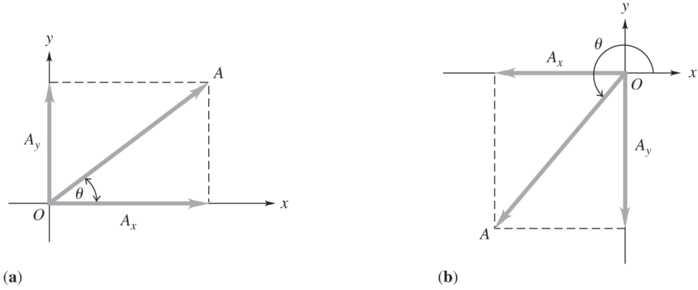
Solve: (a) 2222 (80 lb)(60 lb)100 lb; AAAxy=+=.+.=. 60 lb tan 80 lb y x
A A θ== and 37 θ=.
(b) 22 (24 m/s)(31 m/s)39 m/s; A =−+−= 31
tan
and 232 θ= (My calculator gives 52 φ= and 180)θφ=+.
(c) 22 (1500 km)(2000 km)2500 km; A =−+= 2000 km tan 1500 km θ= and 127 θ= (My calculator gives 53 φ= and 180)θφ=+.
(d) 22 (713 N)(547 N)899 N; A =.+−.=. 547 N tan 713 N θ −. = . and 323 θ= (My calculator gives 37φ=− and 360)θφ=+.
1.44. Set Up: For each vector, use the relations cos x RR θ = and sin y RR θ =.
Solve: For vector : A (120 m) cos (9037)72 m; Ax =.−=. (120 m) sin (9037)96 m Ay =.−=.. For vector : B (150 m) cos (320)115 m; Bx =.=. (150 m) sin (320)96 m y B =.=−.. For vector : C (60 m) cos (240)30 m; x C =.=−. (60 m) sin (240)52 m y C =.=−..
1.45. Set Up: For parts (a) and (c), apply the appropriate signs to the relations x xx R AB=+ and yyy R AB =+. For (b) and (d), find the magnitude as 22 x y R RR=+ and the direction as 1 tan(/) yx R R θ=.
Solve: (a) 130 cm410 cm540 cm; xxx RAB=+=.+.=. 225 cm(375 cm)150 cm yyy RAB=+=.+−.=−.
(b) 2222 (540 cm)(150 cm)560 cm; RRRxy=+=.+−.=. [ ] 1 tan(150 cm)/(540 cm)155 θ= −..−.. The resultant vector thus makes an angle of 3445 . counterclockwise from the +x axis.
(c) ()410 cm(130 cm)280 cm; xxx RBA=+−=.+−.=. ()375 cm(225 cm)600 cm yyy RBA=+−=−.+−.=−.
(d) 22 (280 cm)(600 cm)662 cm; R =.+−.=. 1 tan[(600 cm)/(280 cm)]650 θ=−..=−.. The resultant vector thus makes an angle of 2950 counterclockwise from the +x axis.
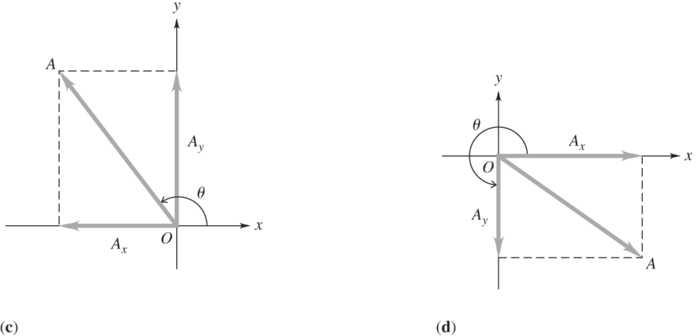
Reflect: Note that B A has a larger magnitude than . + B A Vector addition is very different from addition of scalars.
© Copyright 2012 Pearson Education, Inc. All rights reserved. This material is protected under all copyright laws as they currently exist. No
reproduced,
1.46. Set Up: Use coordinates where +x is east and +y is north. A and B are the two given displacements (see the Figure (a) below). Displacement B makes an angle of 312 θ= counterclockwise from the +x axis. Calculate =+. R AB
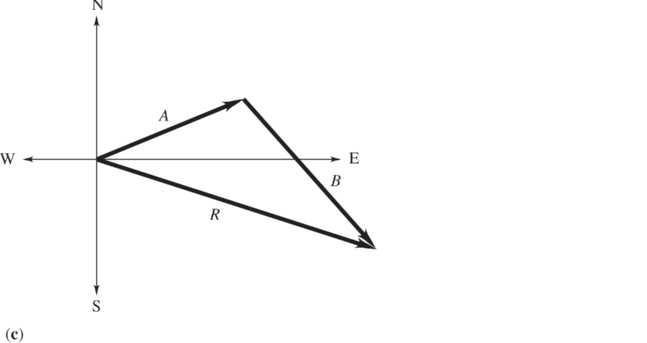
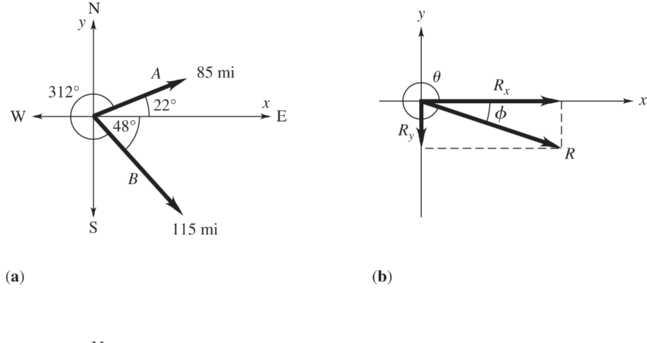
Solve: (a) cos 22(85 mi)(cos 22)788 mi; x AA===.
sin 22(85 mi)(sin 22)318 mi
y AA===..
x BB===.
cos 312(115 mi)(cos 312)770 mi;
y BB===−.
sin 312(115 mi)(sin 312)855 mi
xxx RAB=+=.+.=.
788 mi770 mi1558 mi;
yyy RAB=+=.+−.=−.
318 mi(855 mi)537 mi
RRRxy=+=.+−.=
2222 (1558 mi)(537 mi)165 mi;
or 19 φ= south of east, as shown in Figure (b) above.
537 mi tan 1558 mi θ −. = and 341; θ=
(b) The vector addition diagram for =+ R AB is given in Figure (c) above. The magnitude and direction of R in this diagram agrees with our calculation using components.
© Copyright 2012 Pearson Education, Inc. All rights reserved. This material is protected under all copyright laws as they currently exist. No portion of this material may be reproduced, in any form or by any means, without permission in writing from the publisher.
Models, Measurements, and Vectors

*1.47. Set Up: We know that the two force vectors, A and , B have the same magnitude ( AB = ) and form a right angle; thus, the two forces and their resultant form an isosceles right triangle. Use coordinates for which the resultant force is parallel to the +y-direction and find the magnitude of A and B by setting the y-component of the resultant equal to 620 N.
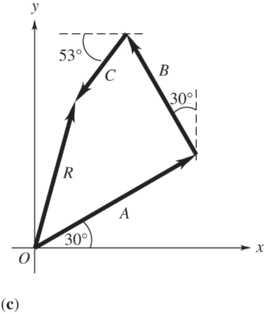

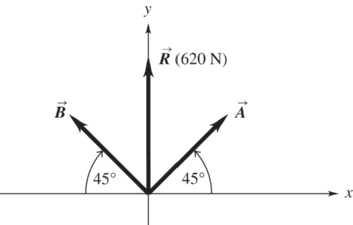
Solve: (a) The two forces and their resultant are shown below.
(b) sin45sin1352sin45620 N. yyy RABABA =+=+== Thus, 620 N 440 N 2sin45 A ==.
Reflect: Note that cos45cos1350 xxx RABAB=+=+=.
1.48. Set Up: The counterclockwise angles each vector makes with the +x axis are: 30, Aθ = 120, Bθ = and 233 Cθ =. The components of each vector are shown in Figure (a) below.
© Copyright 2012 Pearson Education, Inc. All rights reserved. This material is protected under all copyright laws as they currently exist. No portion of this material may be reproduced, in any form or by any means, without permission in writing from the publisher.
Solve: (a) cos 3087 N; x AA== sin 3050 N; y AA== cos 12040 N; x BB==− sin 12069 N; y BB== x C = cos 23324 N; C =− sin 23332 N y CC==−.
(b) =++ R ABC is the resultant pull.
87 N(40 N)(24 N)23 N xxxx RABC=++=+−+−=+ 50 N69 N(32 N)87 N yyyy RABC=++=++−=+
(c) , Rx , y R and R are shown in Figure (b) above.
22 90 N RRRxy=+= and 87 N tan 23 N θ= so 75 θ=
(d) The vector addition diagram is given in Figure (c) above. Careful measurement gives an R value that agrees with our results using components.
*1.49. Set Up: Use coordinates for which x + is east and y + is north. Each of the professor’s displacement vectors make an angle of 0º or 180º with one of these axes. The components of his total displacement can thus be calculated directly from x xxx R ABC=++ and yyyy R ABC =++.
Solve: (a) 0(475 km)0475 km475 km west; xxxx RABC=++=+−.+=.=. 325 km0 yyyy RABC=++=.+
(150 km)175 km175 km north; +−.=.=. 22 506 km; RRRxy=+=. 1 tan(/) RRyx θ== 1 tan[(175)/(475)]+.−.=
202;−. 180202698 west of north φ=−.=.
(b) From the scaled sketch in the figure below, the graphical sum agrees with the calculated values.
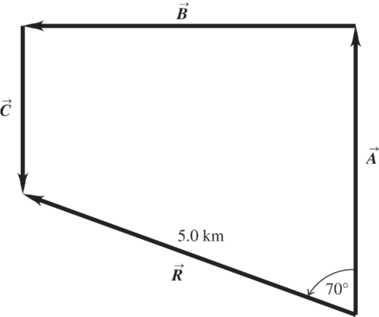
Reflect: The magnitude of his resultant displacement is very different from the distance he traveled, which is 159.50 km.
1.50. Set Up: Use coordinates for which x + is east and y + is north. The driver’s vector displacements are: 26 km, 0 of north; =. A 40 km, 0 of east; =. B 31 km, 45 north of east =.. C
© Copyright 2012 Pearson Education, Inc. All rights reserved. This material is protected under all copyright laws as they currently exist. No portion of this material may be reproduced, in any form or by any means, without permission in writing from the publisher.
Solve: 040 km(31 km) cos (45)62 km; xxxx RABC=++=+.+.=.
26 km0(31 km)(sin 45)48 km; yyyy RABC=++=.++.=. 22 78 km; RRRxy=+=.
1 tan[(48 km)/(62 km)]38;θ=..= 78 km, =. R 38º north of east. This result is confirmed by the figure below.
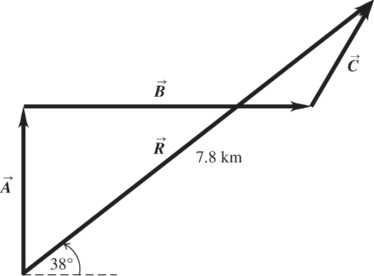
1.51. Set Up: We know that an object of mass 1000 g weighs 2.205 lbs and 16 oz1 lb =.
Solve: 1 lb1000 g (500 oz)142 g 16 oz2205 lb
The acceptable limits are 142 g to 149 g.
and 1 lb1000 g (525 oz)149 g 16 oz2205 lb
Reflect: The range in acceptable weight is 1 4 oz Since 1 4 oz7 g, = the range in mass of 7 g is consistent. As we will see in a later chapter, mass has units of kg or g and is a different physical quantity than weight, which can have units of ounces. But for objects close to the surface of the earth, mass and weight are proportional; we can therefore say that a certain weight is equivalent to a certain mass.
1.52. Set Up: The cookies are roughly cylindrical in shape: the volume of a cylinder with a radius r (or diameter d ) and a height h is 22 1 4 Vrhdh ==ππ
Solve: (a) 23 1 (850 cm)(0050 cm)28 cm 4 V π =..=.
(b) 2 850 cm 1710 0050 cm d h ==.×
Reflect: The accuracy of our answer is limited by the thickness of the cookie, which is only known to two significant figures. Also, the answer to (b) is dimensionless. Why is it better to write the answer to (b) as 17102 .× rather than 170?
*1.53. Set Up: Estimate 12 breaths per minute. We know 1 day24 h, = 1 h60 min, = and 3 1000 L1 m =.
Solve: (a) 60 min24 h (12 breaths/min)17,280 breaths/day 1 h1 day
The volume of air breathed in one day is () 3 1 2 L/breath(17,280 breaths/day)8640 L864 m ==..
The mass of air breathed in one day is the density of air times the volume of air breathed: m = 33 (129 kg/m)(864 m) ..= 111 kg As 20% of this quantity is oxygen, the mass of oxygen breathed in 1 day is (020)(111 kg)22 kg2200 g ..=.=.
(b) 3 864 m . and 3 , Vl = so 13 21 m / lV==..
© Copyright 2012 Pearson Education, Inc. All rights reserved. This material is protected under all copyright laws as they currently exist. No portion of this material may be reproduced, in any form or by any means, without permission in writing from the publisher.
Reflect: A person could not survive one day in a closed tank of this size because the exhaled air is breathed back into the tank and thus reduces the percent of oxygen in the air in the tank. That is, a person cannot extract all of the oxygen from the air in an enclosed space.
1.54. Set Up: To determine the number of breaths in the atmosphere we can divide the mass of the atmosphere by the mass of a single breath. The mass of a single breath is equal to the density of air times the volume of a single breath.
Solve: The mass of a single breath is 33
4
. Thus, the approximate number of breaths in the atmosphere is 1522
4 1000 kg1 breath (510 metric tonnes)110 breaths metric tonne 410 kg
Since this number is roughly the same as the number of atoms in a single breath, there is a good chance that each breath we take contains at least one molecule that was previously inhaled by any given person. Reflect: The answer is only accurate to one significant figure—but that is good enough to show a rather surprising result!
*1.55. Set Up: The volume V of blood pumped during each heartbeat is the total volume of blood in the body divided by the number of heartbeats in 1.0 min. We will need to apply 3 1 L1000 cm =. Solve: The number of heartbeats in 1.0 min is 75. The volume of blood is thus: 23 50 L 6710L67 cm 75 heartbeats V ==.×=.
1.56. Set Up: The x axis is shown to lie along the axis of the bone. Let 275 N F =. be the magnitude of the force applied by each tendon. The angles that the tendons make with the x axis are 200, . 300, . 400, . 500, . and 600..
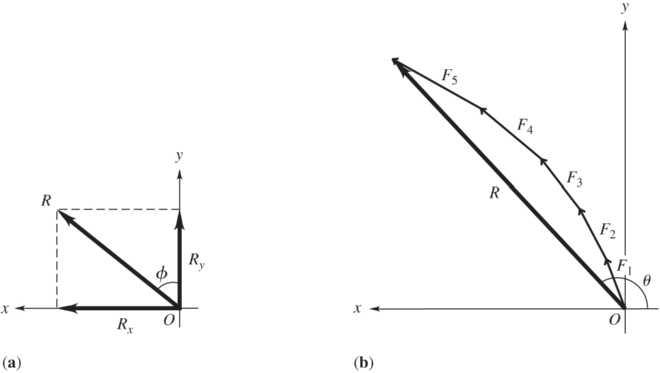
Solve: (a) 12345 x xxxxx R FFFFF =++++
The resultant R and its components are shown in Figure (a) below.
© Copyright 2012 Pearson Education, Inc. All rights reserved. This material is protected under all copyright laws as they currently exist. No portion of this material may be reproduced, in any form or by any means, without permission in writing from the publisher.
(b) The vector addition diagram is shown in Figure (b) above. Careful measurements in the diagram give results that agree with what we calculated using components.
1.57. Set Up: Estimate 2 ft per step and 100 steps per minute. Use: 1 mi5280 ft =.
Solve: (a) The distance is 7 (2160 mi)(5280 ft/mi)11410ft =.×. The number of steps is calculated as this distance divided by the distance per step:
7 6 11410ft 5710steps 2 ft/step .× =.×.
(b) The time in minutes is the number of steps required divided by the number of steps per minute 6 4 5710steps 5710min950 h 100 steps/min .× =.×=.
At 8 h per day it takes about 120 days.
1.58. Set Up: The number of atoms in your body is your mass divided by the mass of one atom. Assume a 70-kg person and that the human body is mostly water. Use the appendix to find the mass of one H2O molecule (by adding the masses for two hydrogen atoms and one oxygen atom): 27 18015 u166110.×.× 26 kg/u299210 =.× kg/molecule.
Solve: 2627 (70 kg)/(299210 kg/molecule)23410.×=.× molecules. Each 2 HO molecule has 3 atoms, so there are about 61027 × atoms.
Reflect: Assuming carbon to be the most common atom gives 31027 × molecules, which is a result of the same order of magnitude.
*1.59. Set Up: Estimate the volume of each object. The mass, m, of an object is equal to its density times its volume: the volume of a sphere of radius r is 3 4 3 Vr =π . The volume of a cylinder of radius r and length l is
2 Vrl =π . The density of water is 3 1000 kg/m
Solve: (a) Estimate the volume as that of a sphere of diameter 10 cm: 5210m43 V =.× 343 (098)(1000 kg/m)(5210m)05 kg m =..×=.
(b) Approximate as a sphere of radius 025m r μ =. (probably an overestimate): 203 6510m. V =.× So 32031714 (098)(1000 kg/m)(6510 m)610 kg610 g m =..×=×=× .
(c) Estimate the volume as that of a cylinder of length 1 cm and radius 3 mm: 273 2810m. Vrl=π=.× So 3734 (098)(1000 kg/m)(2810 m)310 kg03g. m =..×=×=.
Reflect: The mass is directly proportional to the volume.
1.60. Set Up: Assume a weight of 190 lbs, which corresponds to a mass of 86 kg. I estimate the volume V of my body by approximating it as a rectangular solid with dimensions: 67 in12 in8 in .×.×.
=...=.×.=.
Solve: (a) 33 333 3 10m (67 in)(12 in)(8 in)(6410in)010 m 6102in V
3 3 mass86 kg average density860 kg/m volume 010 m === .
(b) According to this estimate, my average density is somewhat less than the density of water. This is sensible; I know I float in water because my body contains air cavities.
*1.61. Set Up: Use coordinates for which x + is east and y + is north. The spelunker’s vector displacements are: 180 m, = A 0º of west; 210 m, = B 45º east of south; 280 m, = C 30º east of north; and the unknown displacement D The vector sum of these four displacements is zero.
© Copyright 2012 Pearson Education, Inc. All rights reserved. This material is protected under all copyright laws as they currently exist. No portion of this material may be reproduced, in any form or by any means, without permission in writing from the publisher.

